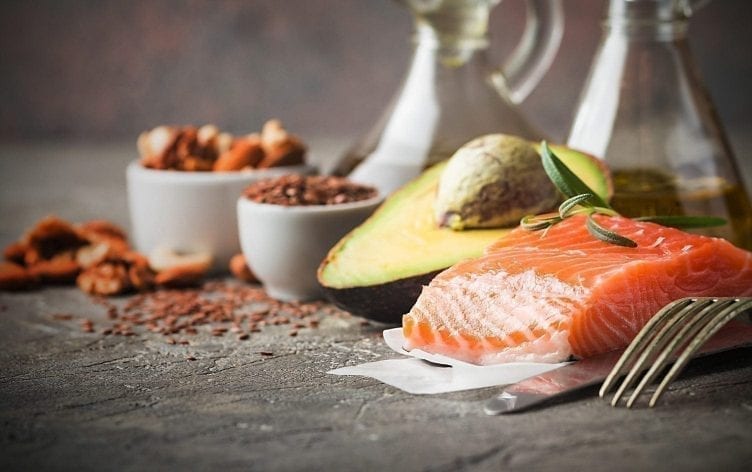Are you afraid of fat? Don’t be. In addition to making food taste good, fat plays an important role in a healthy, balanced diet. Here we cover the basics about fat and how it affects health goals.
脂肪基础
每克9卡路里的卡路里是脂肪最大的脂肪含量最大(碳水化合物和蛋白质均具有4克)。这是有道理的,因为脂肪的最大作用之一是储能。饮食脂肪被消化成脂肪酸的小链。脂肪酸链被肠细胞拾取,重新组装并包装到称为乳糜微粒的血管中,这些血管被发送到肌肉或脂肪组织。一旦乳糜微粒到达,脂肪酸再次被释放,以被肌肉和脂肪细胞吸收。如果您立即需要能量 - 说您在晚餐后散步 - 他们将被用来满足这些要求。如果您直接上床睡觉,它们将被存放在脂肪组织中,直到需要。
毫不奇怪,当您的身体遇到卡路里赤字时,就会发生严重的脂肪崩溃。在健康的成年人中,卡路里赤字主要是通过限制消耗的卡路里或进行艰苦的锻炼。发生这种情况时,您的身体将其挖掘到自己的脂肪储存中,通过称为“β氧化”的过程将它们分解为能量。此过程需要葡萄糖,这可能来自碳水化合物或蛋白质,并且在轻度限制卡路里时最有效。
Not only does the body burn fat during calorie deficits, but it also burns fat during normal day-to-day activities. Fat is the primary source of fuel when you engage in low-intensity movements — from sitting in front of the computer to walking the dog. The body does this so it can spare glucose (the good stuff!) for your brain and red blood cells.
WHY WE NEED FAT
脂肪对生活至关重要 - 如此之多,以至于我们的身体也想出了一种使脂肪的方法,即使我们几乎没有脂肪。多余的碳水化合物和蛋白质都可以转化为脂肪并将其储存为能量。脂肪还可以通过多种方式帮助我们的身体正常工作:
1.脂肪维持健康的细胞,器官和大脑
健康的脂肪具有保护性。它在细胞中起保护作用,因为它是每个细胞膜的重要组成部分或保护入侵者的“壁”。它还通过缓冲器官免受日常生活的影响来保护您的器官。您还需要某些脂肪来建立和维持健康的大脑,这与成分中的60%脂肪.
2. FAT FUELS MOST ACTIVITIES
For day-to-day activities — from sitting in front of your computer to walking the dog — fat is the main fuel our bodies burn for energy. Generally, during activity where your heart rate is less than 70% of its maximal rate, fat serves as your body’s primary source of fuel.
毫不奇怪,当您的身体遇到卡路里赤字时,就会发生严重的脂肪崩溃。When you take in fewer calories than you burn, your body taps into its fat stores, breaking them down for energy through a process called “beta oxidation.” This process requires glucose and is most efficient when you’re mildly restricting calories.
3.脂肪可以帮助您感到饱满并保持更稳定的血糖水平
Fat aids the release of CCK, a hormone that helps you feel satiated after a meal. Pairing high-fat foods with high-carb foods helps prevent a rapid spike in blood sugar because fat slows digestion and the rate at which sugars from carbs enter the bloodstream.
不同类型的脂肪
Fat is found in a wide variety of foods — either naturally occurring or added fat during processing and cooking. Naturally occurring fats tend to be found in dairy, meat and fish, nuts and seeds, oil and fatty fruits (Think: olive oil and avocado). Added fats tend to be found in processed and packaged goods. Not all fats are created equal when it comes to health.
这是食物中常见脂肪的简短分解:
SATURATED FAT
Solid at room temperature, saturated fat mostly comes from animal sources like meat, particularly red meat, and dairy. Certain plants and their oil are high in saturated fat, such as coconut and palm. Virtually all major health organizations advise us to eat less saturated fat since it raises LDL cholesterol, a risk factor for heart disease. This is why theMyFitnessPalapp sets your saturated fat limit at less than 10% of total calories.
反式脂肪
Most trans fat found in food are synthetically made by taking liquid unsaturated fat and blasting it with hydrogen so it resembles solid saturated fat. This makes foods more shelf stable, easier to cook with and allows manufacturers to replace saturated fat in their products. However evidence has revealed trans fats are one of the worst things for your heart. Not only do trans fat increase LDL (bad) cholesterol, but they also decrease HDL (good) cholesterol. The MyFitnessPal app sets your trans fat goal at 0 grams per day.
单不饱和(MUFA)和多不饱和脂肪(PUFA)
These fats are what we think of when we say “healthy” fats because they don’t carry the same risk for heart disease as saturated and trans fat. Generally, MUFA and PUFA are found in high-fat, plant-based foods such as avocado, nuts, seeds, olives and fatty fish such as salmon, tuna and mackerel.
Omega-3和Omega-6
尽管它们是技术多不饱和的脂肪,但Omegas应该得到单独的呼叫,因为我们的身体无法产生它们,我们必须从吃的食物中得到这些。Omega-6和Omega-3脂肪都在调节我们的免疫系统中起着重要作用。Omega-3脂肪在发展我们的视力和神经系统中起着至关重要的作用。成人的足够摄入量范围从omega-6脂肪每天12-17克,omega-3脂肪每天为1.1-1.6克。我们很容易从食物中获得足够的omega-6脂肪,因为大豆,红花和玉米油中的食物供应丰富。omega-3脂肪很难获得,因为它们主要是在脂肪鱼中发现的。这就是为什么建议我们吃更多海鲜的原因Dietary Guidelines for Americans.
目标脂肪目标
The Institute of Medicine (IOM) suggests that fat makes up 20–35% of total calories, but you can certainly eat more or less depending on your goals. The MyFitnessPal app automatically allots 30% of calories to fat — of course, you can tailor this to meet your needs.
To determine your fat needs in grams:
- Decide what percentage of your calories you want to come from fat. Choose a 20%, 25%, 30% or 35% fat diet. Convert this number into a decimal (for example, 30% is 0.3).
- Multiply your “Total Calorie Goal” (your calorie goal given by the MyFitnessPal app) by the decimal value. This gives you the number of calories from fat.
- Divide the number of calories from fat by 9 to get the grams of fat.
Does this match your fat goal in the app? Adjust it if needed.
WAYS TO OPTIMIZE FAT CONSUMPTION
1.吃适量的肉和乳制品
肉类和乳制品肯定在任何均衡饮食中都起作用,但由于脂肪饱和,因此它们不应构成您的大部分摄入量。适度地享受它们,以及大量的全谷物,蔬菜和水果。
2. PAIR WITH NUTRIENT-DENSE FOODS
Eating fats along with foods rich in fat-soluble vitamins and minerals allows your body to better absorb them. A good example: Use high-fat salad dressing to maximize your absorption of the vitamins and minerals from the vegetables in your salad.
3. CHOOSE FOODS HIGH IN OMEGA-3 FATS
Most of the fat in our diets supplies us with plenty of omega-6 fats, but we should be getting a better balance between omega-6 and omega-3. Both fats play a role in keeping inflammation in check, so it’s important we get a good ratio of the two.
4. VARY YOUR COOKING OIL
不同的食用油提供不同量的饱和脂肪,mufa和pufa,再加上食物的不同风味和香气。为了以精通预算的方式获得最大收益,请购买橄榄油(用于低加热烹饪)和菜籽油(用于高热烹饪)。橄榄油提供有价值的MUFA和Omega-6脂肪,但低芥酸菜籽也有大量的Omega-3脂肪。
5. EAT FOODS RICH IN HEALTHY FATS
将饮食集中在单不饱和和多不饱和的脂肪上,例如以下列出的脂肪:


3 FAT MYTHS, DEBUNKED
The nutrition field has recovered from its fat-phobia of the ‘90s. Just in case any of those old beliefs are lurking in your mind, we want to be extremely clear.
1. EATING FAT WILL MAKE YOU FAT
Your body stores fat mainly from excess calories. If a calorie excess is available, even if those calories are from carbs or protein, your body is fully capable of turning them into fat for storage.
2. YOUR BODY ONLY USES CARBS DURING EXERCISE
您的身体会燃烧碳水化合物,脂肪和蛋白质的组合。脂肪是静止和低强度运动期间选择的燃料(例如,以低于70%的最大心率锻炼)。当您更加努力运动时,您身体的选择燃料会转向碳水化合物 - 以中等强度的速度及以后。
3.吃低脂和非脂肪食物可节省卡路里
Contrary to what the label might tell you, low-fat and nonfat versions of foods tend to contain more fillers and additives to make up for missing flavor. A common additive is, unsurprisingly, sugar (or any one of its44 cousins).
READ MORE ESSENTIAL GUIDES

